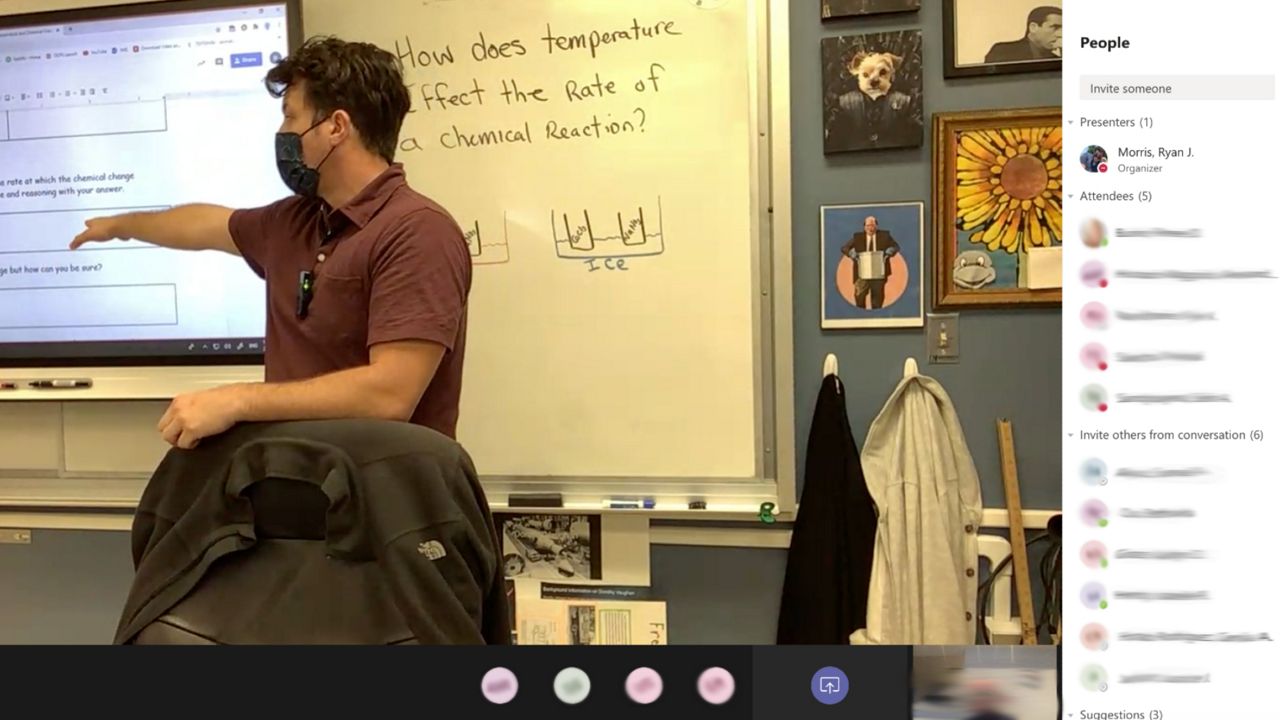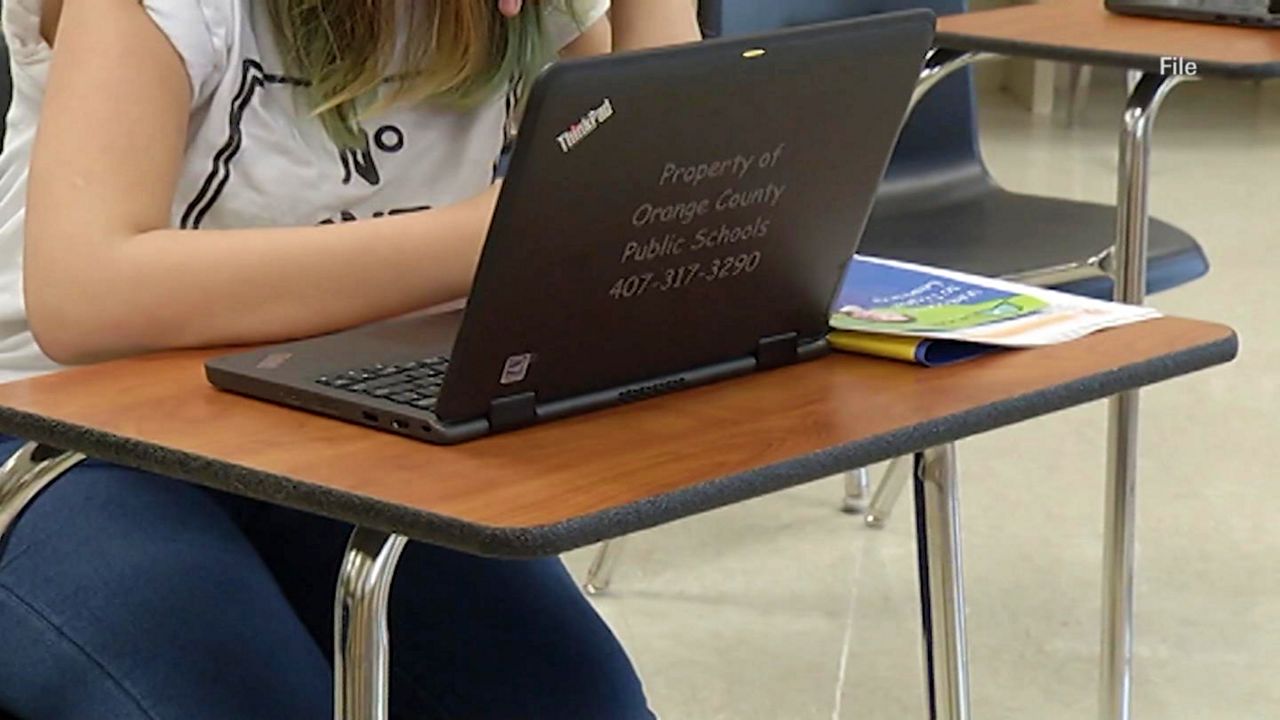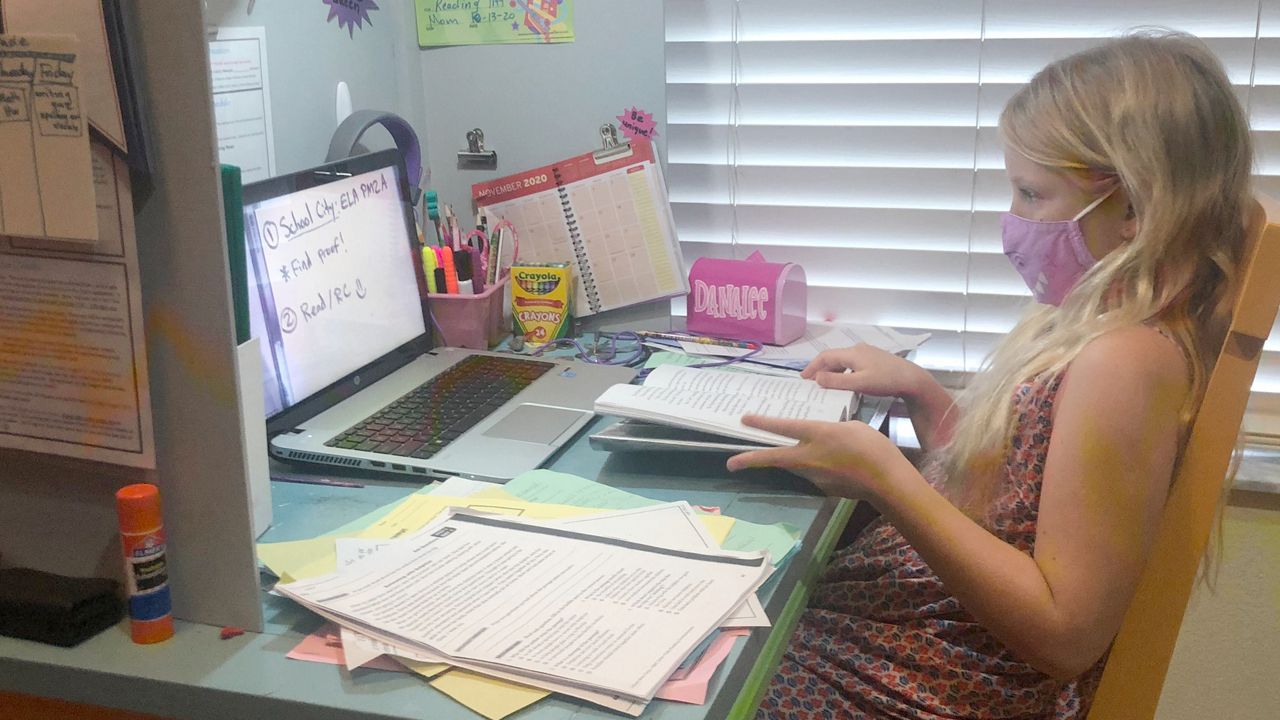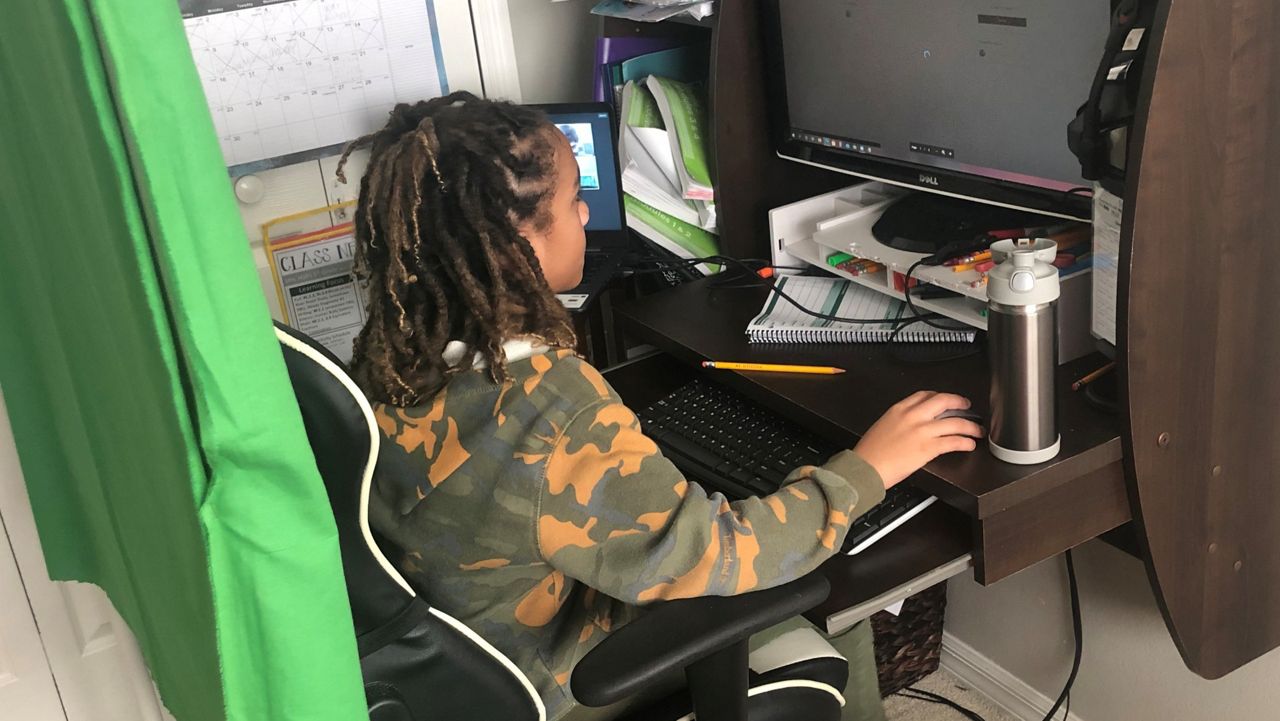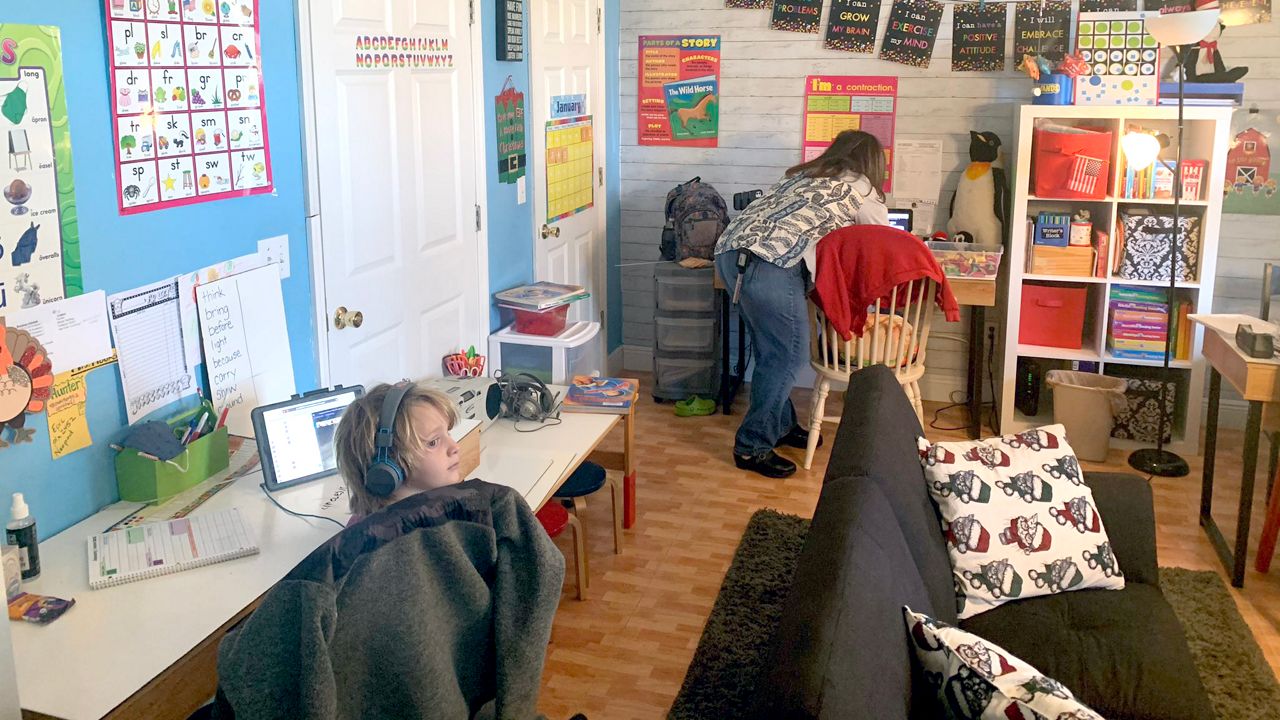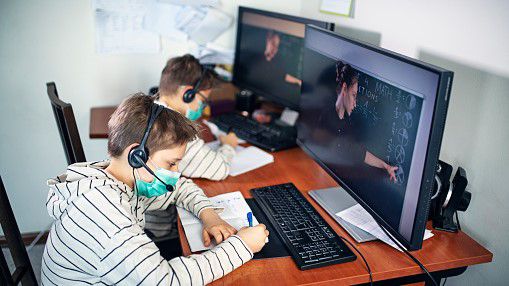ORLANDO, Fla. — During his eighth-grade science class, teacher Ryan Morris talks his students through a written exercise.
What You Need To Know
- Class has 5 online, 17 in-person students, consistent with Orange County trend
- District requires masks but provides flexibility on distancing, offering “general guidance”
- Teacher Ryan Morris: ““We would prefer them all to be back in person”
- Student: “Online it’s a little trickier because sometimes the Wi-Fi goes out”
- RELATED: CDC Unveils Guidelines for Reopening Schools Safely; Vaccination of Teachers Not a Prerequisite
He reads aloud question No. 1, and he emphasizes that students must include evidence and reasoning with their answer.
“So, do not just say, ‘Yes,’” he tells his students.
“Yes,” one of them responds aloud.
Behold eighth grade in 2021.
From the perspective of an observer, especially an older one, it hasn’t changed much over the past several decades.
From the perspective of a student, especially one who attends online, it has changed drastically over the past several months.
Spectrum News 13 last week sat in virtually on Morris’s fifth-period class at Windy Ridge K-8, a so-called School of Innovation in Orange County Public Schools. We signed in as a student would in OCPS’s LaunchEd@Home digital learning model, through which thousands of students attend class virtually during the coronavirus pandemic.
Via streaming video, online students observe the teacher instruct class in real time. They see their peers in the classroom and can interact with them through video or chat.
They can virtually raise their hand with the click of a button. They even get called on for questions, as a student named Kyle did during a lab that aimed to show students how temperature affects chemical reactions.
An Observation From Home
Kyle, three fellow online students, and Spectrum News 13 are logged on as Morris demonstrates an experiment that involves baking soda, calcium chloride, hot water, and cold water. From our computers, we see only the teacher’s hands and lab materials, and we hear clinging from his station and five student stations.
“OK, so Kyle …” Morris says. “You’re going to have to talk out loud so we can hear you.”
“Hello,” Kyle says.
“Hello, Kyle,” Morris says.
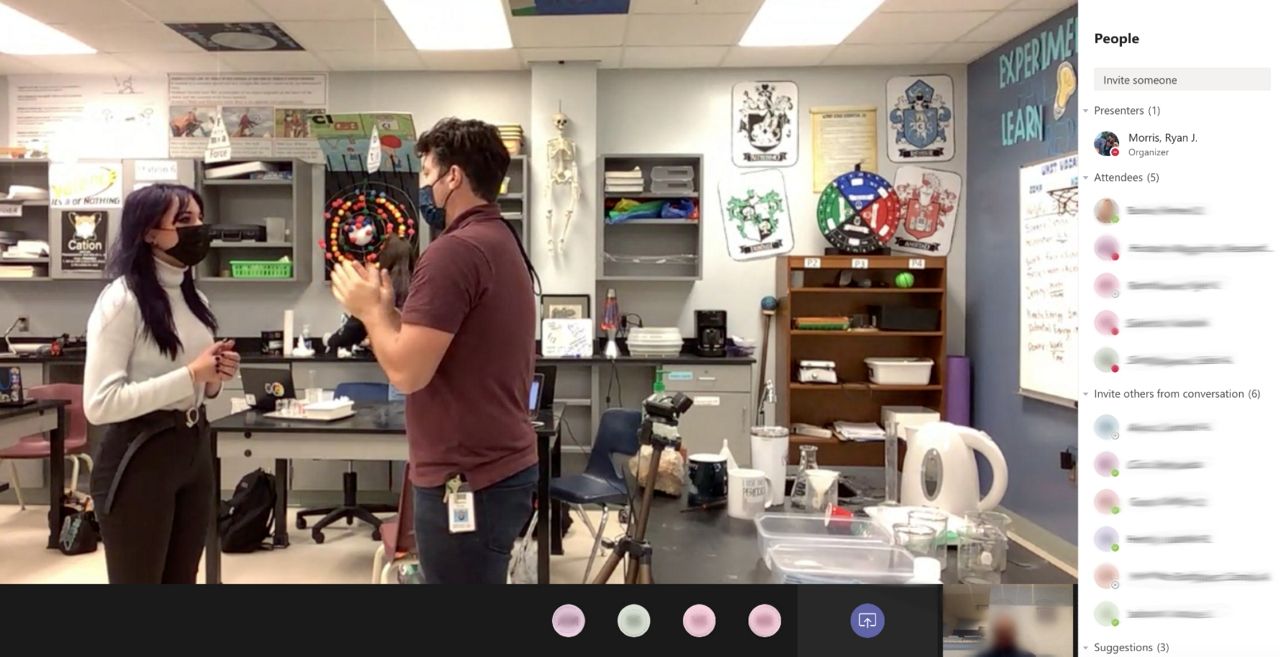
Ryan Morris talks to a student during his 8th-grade science class at Windy Ridge K-8. (Screen capture)
Morris asks Kyle to explain the effects of hot and cold on molecular movement.
Kyle explains that molecules move faster in hot water, “going super-speed,” than in cold water.
“He’s not wrong,” one in-class student says.
“He’s not wrong!” Morris agrees, then expands the conversation.
So went Spectrum News 13’s online observation, which came amid debates about whether schools pose a risk to the spread of COVID-19, whether schools should remain open during the pandemic, whether the state’s vaccination schedule should prioritize teachers, and whether online learning impedes a student’s progress.
Florida stands among four states that have ordered schools to remain open during the pandemic, according to EducationWeek, a K-12 news and information resource. Five states have established partial closures, and most other states have left the decision to school districts.
Calling online learning “just not the same” as in-class instruction, Florida Gov. Ron DeSantis said in November that schools would remain open during 2021, with a continued option to learn from home.
In an emergency order, Florida Education Commissioner Richard Corcoran required schools to alert parents if their children weren’t making “adequate progress” in an “innovative learning modality” such as OCPS’s LaunchEd. The order required such children to return to face-to-face instruction in January unless their parents disagreed.
Return-to-School Trend
Forty two percent of OCPS’s 197,000 non-charter-school students attended school in person in late November, before a surge to 54% in early January and to 57% in early February, according to data from district spokeswoman Renee Burke.
Burke said the district encourages struggling online students to return for face-to-face instruction. But she emphasized in an email to Spectrum News 13 that not all students who returned to physical schools after the winter break did so because of the education commissioner’s order.
“We did not ask people to state why they were returning to face-to-face instruction,” Burke said in an email to Spectrum News 13.
In Ryan Morris’s fifth-period physical science class, five of 22 students now attend from home, though only four were logged on when we observed the class last week. All 22 students started the class online in August, and about half of them remained online after winter break, Morris said.
Some students have returned to physical classrooms because of grades and some because their parents wanted them there, he said.
“We would prefer them all to be back in person,” Morris told Spectrum News 13, “because it’s almost impossible for me to talk with them one-on-one.”
Online Learning: The Technology
Morris’s class combines audio and video technology and Canvas, a web-based platform that lets all students access course work, materials and activities and turn in assignments online.
A camera follows him around the classroom so that online students can see him. He can switch to a camera that shows other parts of the room, including students. And instead of live video, he can show a class handout.
As Morris walked around his classroom last week, we saw a masked teacher and masked students, most of them distanced while at their desks.
When the camera caught the front of the room, we saw the online platform homepage and the initials of all four present online students projected on the blackboard. Had those online students turned on their computer cameras, their faces instead of their initials would have gotten projected for their teacher and in-person classmates to see.
But Morris doesn’t make them turn on their cameras.
“To them, they’re on that board front-and-center,” he said after class. “So their house is on display and they’re on display, and it’s a level of discomfort that they don’t like.”
He said he also sympathizes with online students for having to sit at their laptops for 7 ½ hours a day.
Morris kept a clipboard on which he checked off names of students whom he called on for in-class questions — just to remind himself to keep everybody engaged.
“If you are in this online classroom and no one ever talks to you, you’re going to think that no one thinks that you exist,” he said, “or you’re going to be less inclined to pay attention.”
Class Begins
Last week’s class starts with the way most eighth-grade classes begin: with lots of chatter. We initially fail to connect to the video, so we listen from our laptop as Morris asks — or tries to ask — in-class and online students the status of a poster project.
It reminds us of the patience, persistence and personality — the magic — it must take to teach young teenagers.
“Guys, I can’t hear,” Morris says to his students.
Then he says: “Allesandro … is he online?”
Then: “Jordan? Yes. OK, Camilla. You?”
Then to another student: “I can’t hear what she’s saying when you’re saying something. Thank you.”
Morris tells his students that they’ll be doing a simple lab experiment on how temperature affects chemical reactions. A document that shows the lab materials shows up on our computers.
Morris switches his camera so that we see only his hands and the lab materials, including beakers, plastic containers, measuring spoons, baking soda and calcium chloride.
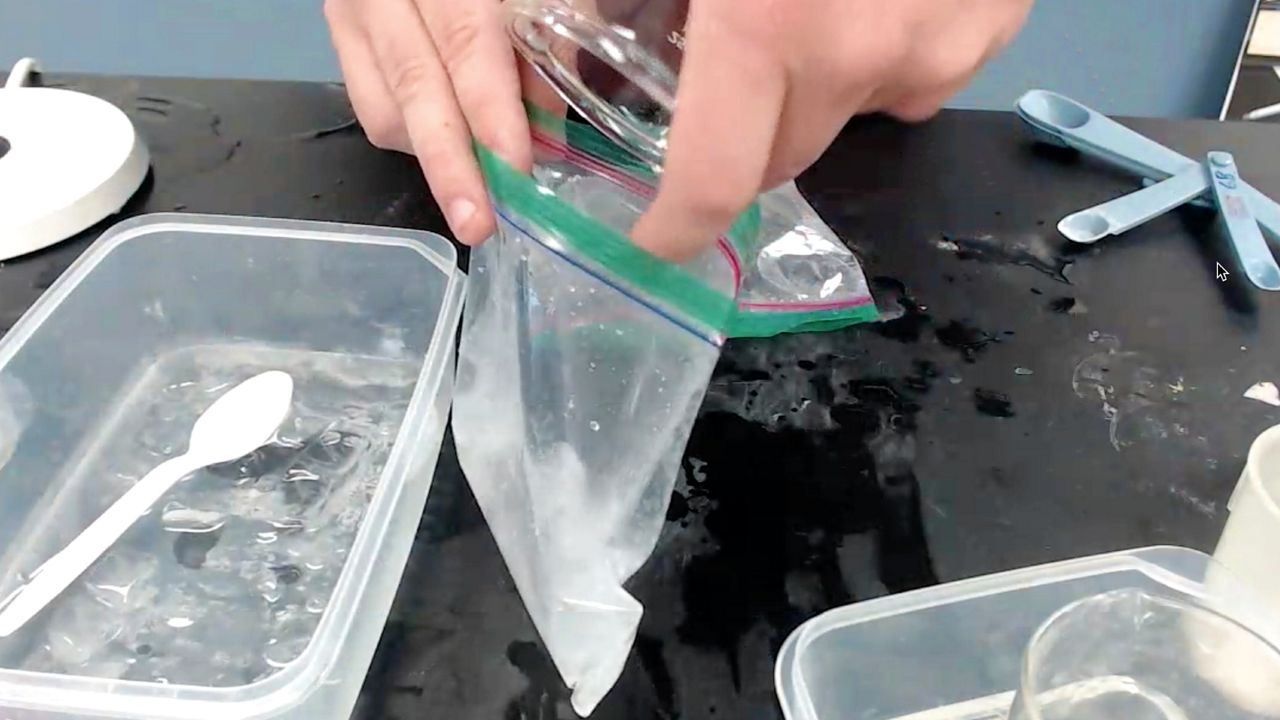
Science teacher Ryan Morris's experiment is shown to students attending class from home. (Screen capture)
“If we were to just put these in water and combine them, we would get a reaction,” he tells his students. “We want to try to amplify that reaction best we can by increasing the temperature of the reaction.”
He tells students to organize their tables and gives them step-by-step directions on the experiment. Online students are expected to observe — this isn’t an experiment to do from home — and to be ready to answer questions.
In-class students add and dissolve ingredients as directed. We can’t see them do it because the camera remains on Morris’s hands and ingredients. But in the background, we hear stirring and clanging, plus talking and giggling.
“While they’re stirring, Vaishali — online, Vaishali — is this a chemical change or a physical change — me just dissolving and making solutions?” Morris asks.
Through continued clinging and chatter, we hear a faint response.
“Vaishali’s got this,” Morris says to students. “I can’t hear her because you’re all talking. I asked Vaishali. I can’t hear you, Vaishali.”
We hear no detectable response. Morris says something’s wrong with the online audio.
A Student’s Perspective
“Sometimes the audio doesn’t go through and the teacher just continues on,” Vaishali Salecha, the student, told Spectrum News 13 by telephone, referring to her experience with online learning in general.
About her overall experiences, she said: “It’s pretty good. What I like is that I can focus without distractions that I could have in class, like people talking in the background. But online it’s a little trickier because sometimes the Wi-Fi goes out, and it’s not as interactive as when you’re in class.”
Vaishali said she plans to finish the school year online.
Her father, Rajendra Salecha, said he prefers in-person instruction for his daughter and for a son who attends Olympia High School. That would give them “a much better learning environment, and the teachers wouldn’t have to worry about this dual kind of learning mode.”
“But at the same time,” he said, “the risks with COVID are still there.” A family member carries an increased risk of illness from COVID-19, so “we have to be careful,” he said.
Morris kept his mask on for most of last week’s class, once briefly removing it while he spoke at the front of the room. His students kept their masks on throughout, at least as far as we could see. We couldn’t get an idea of the distancing during much of the class, especially during the lab when the camera stayed on Morris’s lab ingredients.
After the lab, students appeared generally distanced at their desks, except for one case in which three students sat at a small table.
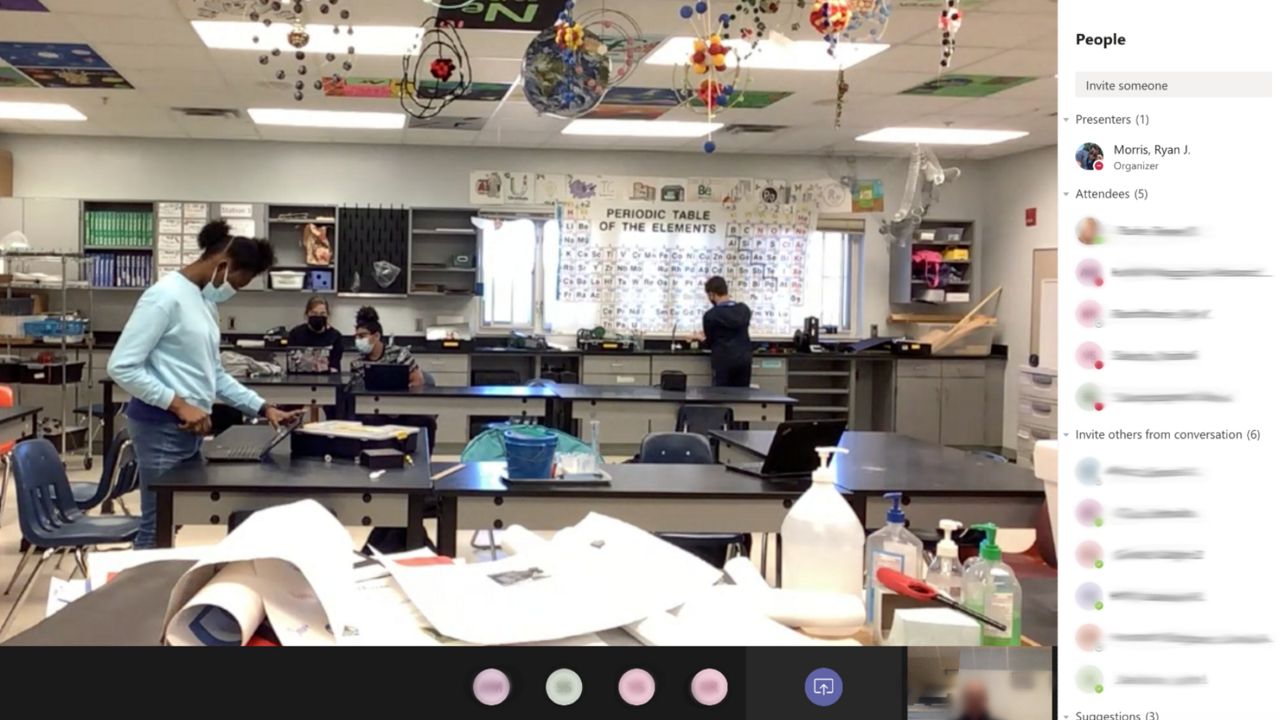
Students work at their desks and clean up after a lab experiment in Ryan Morris’s 8th-grade science class at Orange County's Windy Ridge K-8. (Screen capture)
Morris said one of his classes includes seven in-person students, which makes spacing much easier.
For his fifth-period class, the one we observed, he said he must space out 17 in-person students in a room built for 25.
“With 17 it’s hard to keep distance, but their regular seats are distanced as far as they can possibly be,” he said.
OCPS Guidelines
Orange County Public Schools’s COVID-19 Health and Safety Procedures Manual requires masks but provides flexibility on distancing, offering “general guidance” including the arrangement of desks so that “students are as physically distanced as possible.” The manual also calls for a recommended distance for staff and students of six feet, “when feasible.”
Asked last week about that flexibility and any steps OCPS was taking as more students returned to in-person instruction, Chief Communications Officer Scott Howat said at an Orange County news briefing: “Teachers are doing everything they can to keep desks separated within a three- to six-foot separation. They keep track of those seating charts and measurements between, because they work with the Florida Department of Health when it comes to contact tracing if there is a case.”
All classrooms include soap, hand sanitizer, and wash areas, he said.
He said the district sees bigger concerns in common spaces such as cafeterias and hallways, where it has established one-way walkways to promote social distance.
Morris said one student among all of his classes has tested positive for COVID-19 this year. That student’s health is fine, he said.
But he braces for the next one, from a health and educational standpoint.
“At any moment, I can get an email saying this person is quarantined for 14 days,” he said. “So we have to be able to flip them online in a matter of one day to get them ready to learn for those two weeks online.”
How 5th Period Ends
We continue to observe and listen to Morris’s fifth-period science class. A few minutes ago, a student had asked the teacher whether his and his wife Heather’s coming baby would be a Cancer or a Gemini.
“Hold on,” he said, then said to the class: “While you guys are working, let me call out people for homework.”
Then he answered the question.
“When’s the cutoff for those signs?”
Now class is wrapping up, and the in-person eighth-graders are becoming inquisitive again.
“Do you like pasta?” a student asks.
“Do I like pasta?” Morris responds. “I don’t seek out spaghetti and meatballs.” He says he likes carbonara.
Moments later, he says to his students, “OK, guys the bell’s about to ring. Online, you can take off.” And referring perhaps to that written class exercise, he adds: “Make sure you guys turn that in.”




